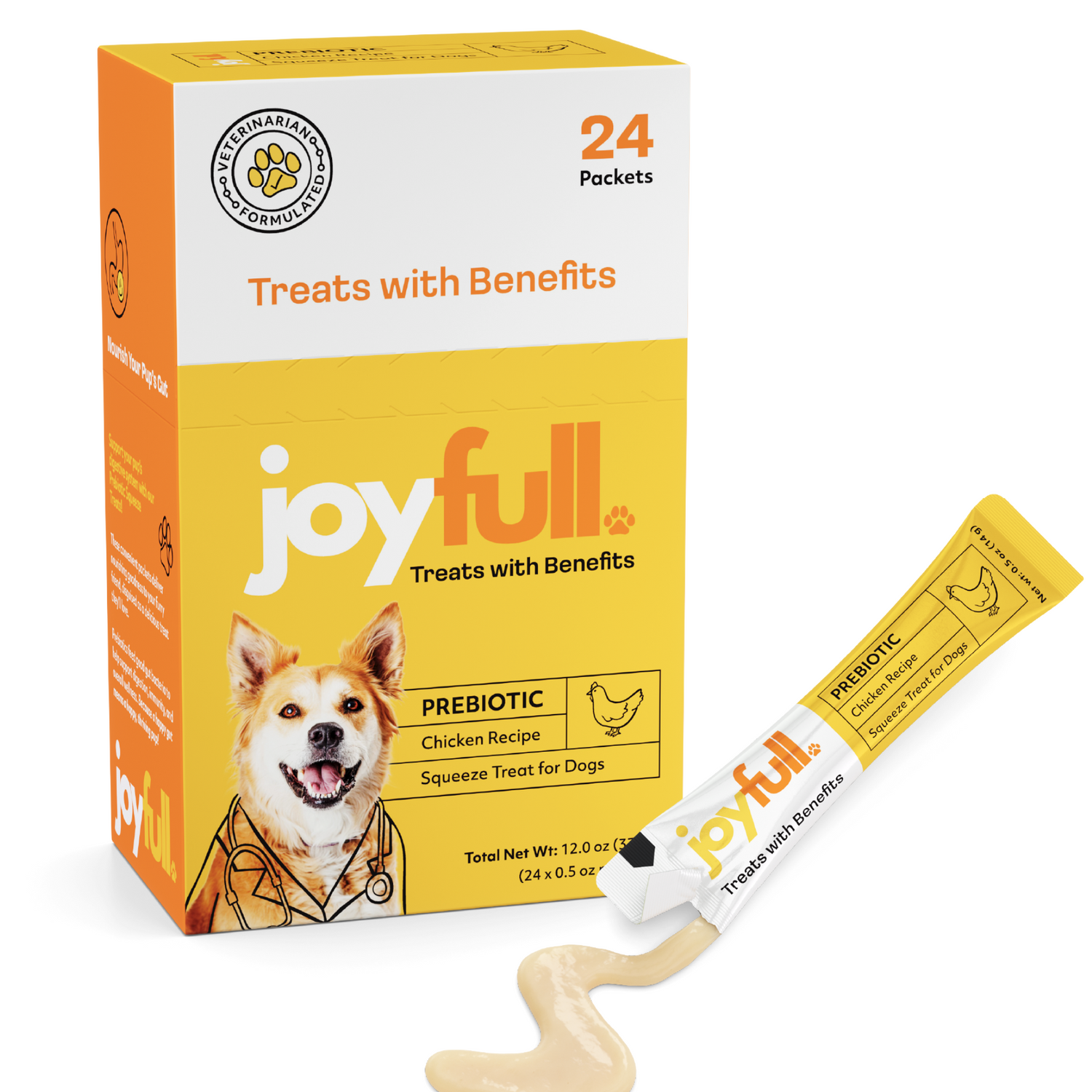
Is Organic Peanut Butter for Dogs Safe & Healthy?
Absolutely, dogs can enjoy organic peanut butter. Just make sure it’s the right kind – one that's free from xylitol, added sugars, and salt. When you go for an organic version, you're choosing peanuts grown without synthetic pesticides, which is a much cleaner and safer bet for your best friend.
Why More Pet Parents Are Going Organic
We're not just pet owners anymore; we're pet parents. That simple shift in how we see our dogs—as true members of the family—is completely changing the pet food aisle. We want the same high-quality, clean ingredients for them that we look for in our own food.
This isn't just some passing fad. Choosing organic peanut butter for your dog is a deliberate move toward ingredients you can actually trust. When you see that "organic" seal, it's a guarantee that the peanuts were grown without a chemical cocktail of synthetic pesticides, herbicides, or genetically modified organisms (GMOs).
That means you're limiting your dog's exposure to residues that have no business being in their snack time.
What “Organic” Actually Means for Your Dog
It’s just like when you’re at the grocery store. You might reach for the organic apples to skip the pesticides and waxy sprays. The exact same thinking applies to your dog's treats. An organic peanut butter gives you confidence that what you're offering is pure and close to its natural state.
This isn't just a feeling people have; the numbers back it up. There's a huge global demand for cleaner, organic pet nutrition.
The market for organic dog food, which includes treats like peanut butter, was worth about USD 8.49 billion worldwide in 2022. It's expected to jump to USD 10.41 billion by 2025, which shows a massive consumer shift toward cleaner pet products. You can dive deeper into the organic pet food market trends and its growth.
It's More Than a Label—It's a Health-First Mindset
At the end of the day, this is all about being proactive with our pets' health. We're reading labels, demanding simple ingredients we can recognize, and taking charge of their well-being for the long haul.
An organic peanut butter treat is a perfect example of this philosophy in action. It’s a small, easy change that reflects a much bigger commitment to wellness. It's a reward you can feel genuinely good about giving.
Now that we understand why clean ingredients matter so much, let's get into the specifics of what to look for—and what to run from—when picking out the perfect jar for your pup.
How to Read Labels and Avoid Hidden Dangers
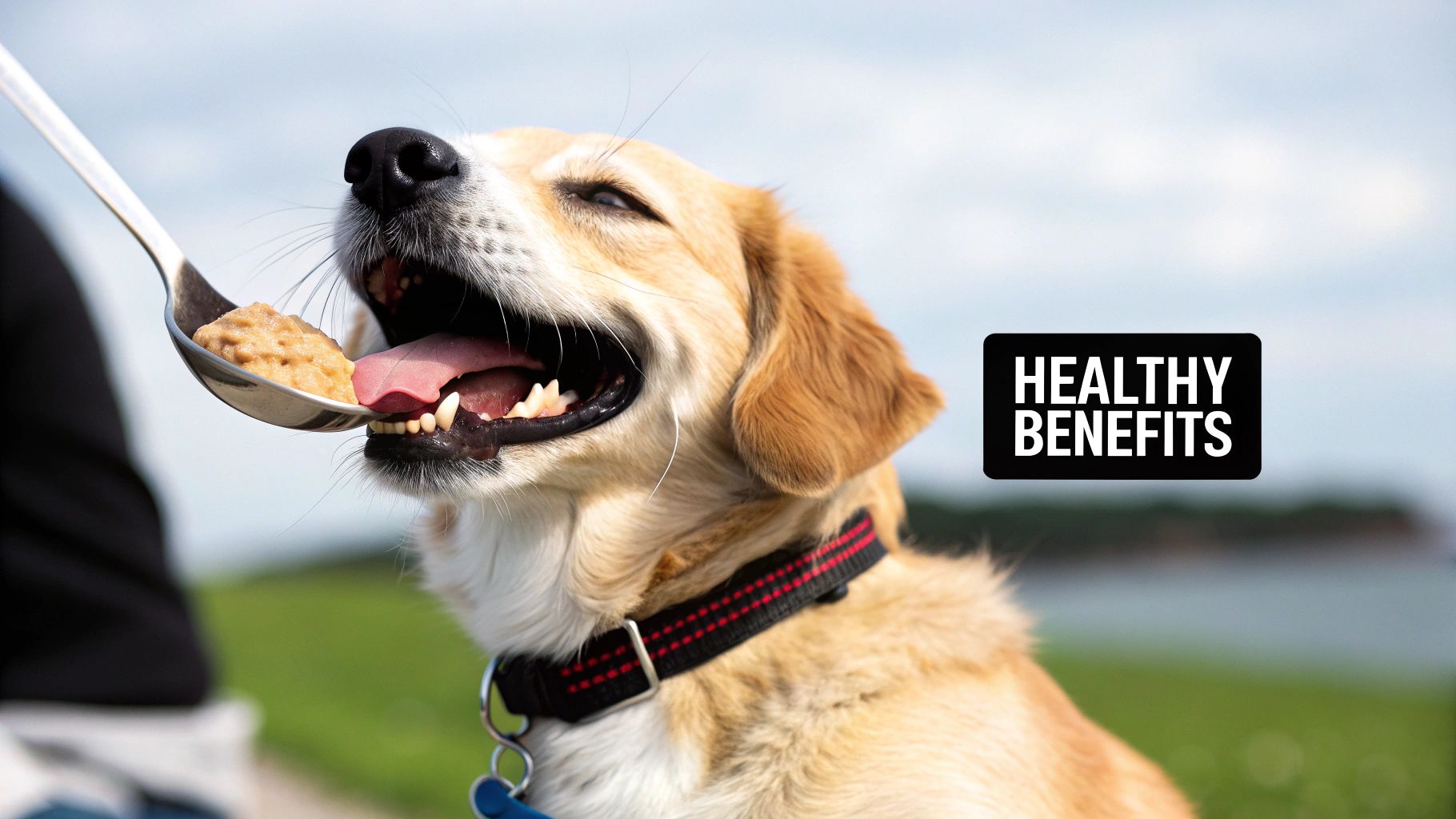
Wandering down the peanut butter aisle seems simple, right? But for a dog owner, it can feel more like navigating a minefield. Many jars on the shelf contain common ingredients that are surprisingly dangerous for our pups. Learning to read the label isn't just a good habit—it’s a non-negotiable skill for keeping your dog safe and healthy.
The most critical ingredient to avoid at all costs is xylitol. This artificial sweetener is completely harmless to people but devastatingly toxic to dogs.
Even a tiny amount can trigger a catastrophic drop in blood sugar (hypoglycemia), which can quickly lead to seizures, liver failure, and death. It's not an exaggeration to say it's a poison for dogs. If you see xylitol on the ingredients list, put the jar back. No exceptions.
Beyond Xylitol: Other Sneaky Additives
While xylitol is public enemy number one, it’s not the only thing to watch out for. Most peanut butters are made to please human taste buds, loading them up with extras that are no good for a dog's system.
When you're shopping for your furry friend, the mission is simple: find the shortest ingredient list possible. Here are the other red flags to look for:
- Added Sugars: Dogs have zero nutritional need for extra sugar. Over time, it can lead to obesity, dental decay, and even set the stage for metabolic problems like diabetes.
- High Sodium Content: Just like with us, too much salt is bad news for dogs. It can cause everything from excessive thirst to sodium ion poisoning in severe cases. Always reach for unsalted or no-salt-added options.
- Palm Oil: Though not toxic like xylitol, palm oil is packed with saturated fats that can wreak havoc on a dog's digestive system, often causing vomiting or diarrhea. Worse, a large amount can trigger a painful and serious inflammation of the pancreas, known as pancreatitis.
The gold standard for dog-safe peanut butter is a jar with just one ingredient: organic peanuts. If there's anything else on that list, it's time to put on your detective hat and investigate before you buy.
Becoming a Label Expert
Getting into the habit of flipping the jar over and scanning the ingredients is one of the most important things you can do as a pet parent. The claims on the front—"natural," "simple," "wholesome"—are just marketing. The truth is always on the back.
This simple act empowers you to know exactly what you're feeding your dog, separating the genuinely good stuff from the potential hazards. To get even more confident in your choices, learning how to read dog food labels is a fantastic skill to master. Your dog is counting on you to be the gatekeeper of their snack cabinet
The Real Health Benefits for Your Dog
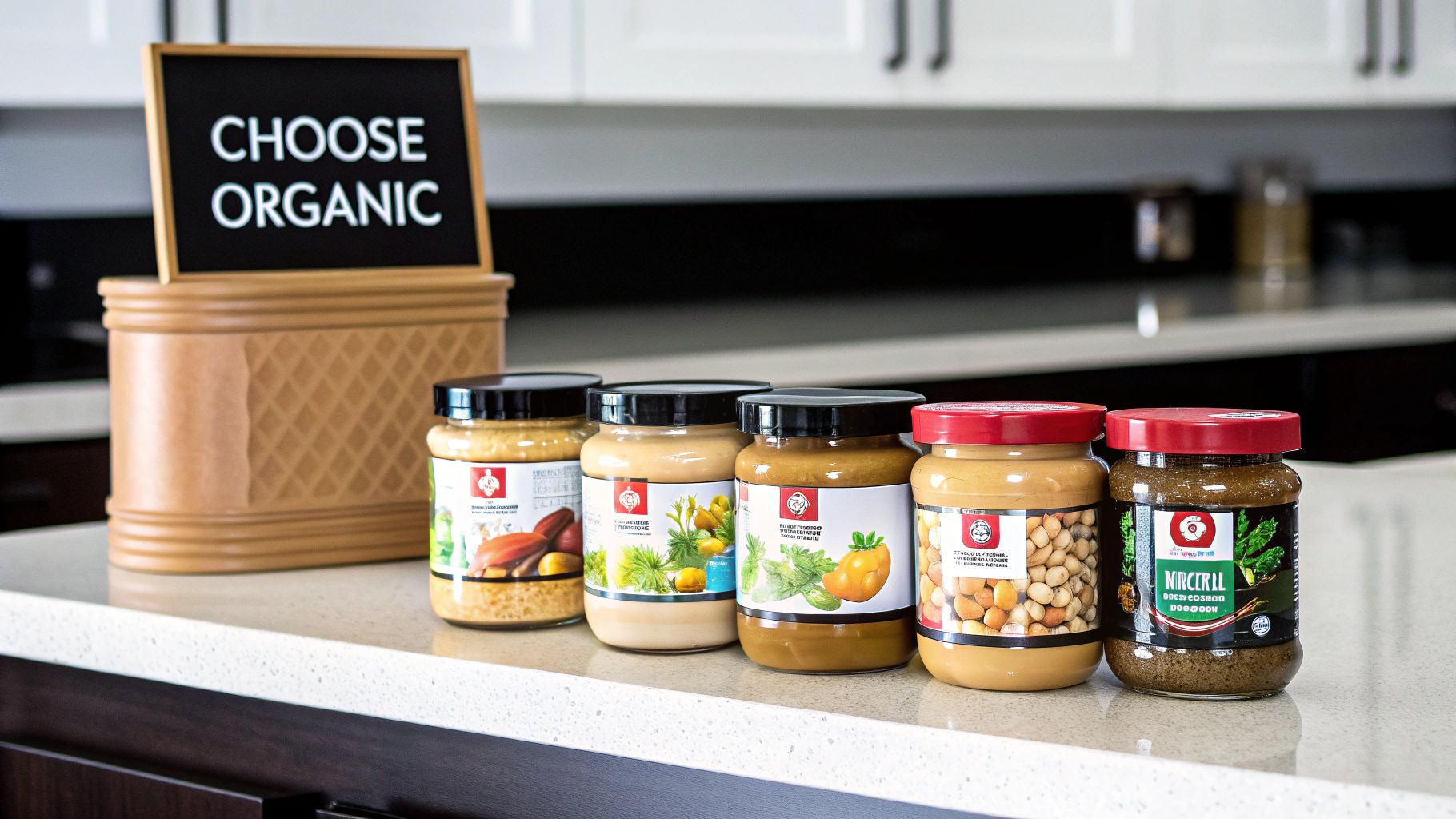
When you pick out a jar of pure, organic peanut butter for your dog, you're giving them more than just a tasty distraction. A spoonful of the right stuff is packed with nutrients that can genuinely support their health. Think of it as a little wellness boost hidden inside their favorite treat.
Beyond that nutty flavor they go crazy for, this simple snack delivers high-quality protein, which is essential for building and repairing muscle tissue. It doesn't matter if you have a canine athlete or a professional couch potato; that protein helps keep their body in top shape, fueling everything from backyard zoomies to muscle recovery after a long walk.
This shift toward healthier treats isn't just a small trend. The market for natural dog treats, which includes organic peanut butter, is expected to explode from USD 6.26 billion in 2023 to over USD 14.03 billion by 2030. It just goes to show how many of us are looking for snacks that do more than just taste good. You can find more details in this market analysis on natural dog treats from Grandview Research.
A Powerhouse of Healthy Fats and Vitamins
One of the best things about pure organic peanut butter is its healthy fat content. It’s loaded with monounsaturated fats—the "good fats"—that are crucial for your dog's overall well-being.
These fats work like an internal moisturizer, helping to keep your dog's coat shiny and their skin healthy. If you’ve noticed your dog has dry skin or a dull coat, adding these fats to their diet can make a real difference. They also provide a slow, steady release of energy to keep your pup going all day long.
But that’s not all. Organic peanut butter is also a great source of essential vitamins that contribute to their vitality.
- Vitamin E: A powerful antioxidant that helps protect cells from damage while supporting healthy muscles and good eyesight.
- Niacin (Vitamin B3): This is key for turning food into energy. Niacin helps maintain a healthy metabolism and even supports brain function.
- Vitamin B7 (Biotin): Often called the "beauty vitamin," biotin is fantastic for promoting a lush coat, strong nails, and healthy skin.
When you choose wisely, organic peanut butter stops being just a treat. It becomes a functional part of your dog’s diet that contributes directly to their muscle health, skin and coat, and energy levels. It proves that a healthy snack can also be their absolute favorite, making it a valuable addition, not just a source of empty calories.
Your Checklist For Choosing The Right Jar
Walking down the peanut butter aisle can feel surprisingly complicated when you're shopping for your dog. But don't worry, once you know what to look for, picking the right jar is actually pretty simple.
Think of it as a quick safety check. Your goal is to find the absolute purest, simplest option on the shelf. That's how you know every spoonful will be a safe and healthy treat.
The Golden Rules Of Selection
The first and most important rule is non-negotiable: no xylitol. This artificial sweetener is incredibly toxic to dogs, so if you see it on the label, put the jar back immediately. No exceptions.
After that, it's all about simplicity. The best peanut butter for your dog will have a very short ingredient list. In a perfect world, it has just one ingredient: organic peanuts.
Here’s what to keep an eye out for when you're comparing brands:
- No Added Sugar: Your dog doesn't need sugar. It just adds empty calories that can lead to weight gain and other health problems down the road. Always grab the unsweetened jar.
- Unsalted Is Best: Too much salt isn't good for dogs, just like it isn't for us. Look for labels that clearly state "unsalted" or "no salt added."
- Avoid Extra Oils: Some brands add palm oil or other hydrogenated oils to prevent separation. Skip these. Those extra fats aren't necessary and can sometimes cause an upset stomach or even contribute to pancreatitis.
This little checklist becomes second nature after a while. The infographic below is a great visual reminder of the most important steps, from checking the label to figuring out the right serving size.
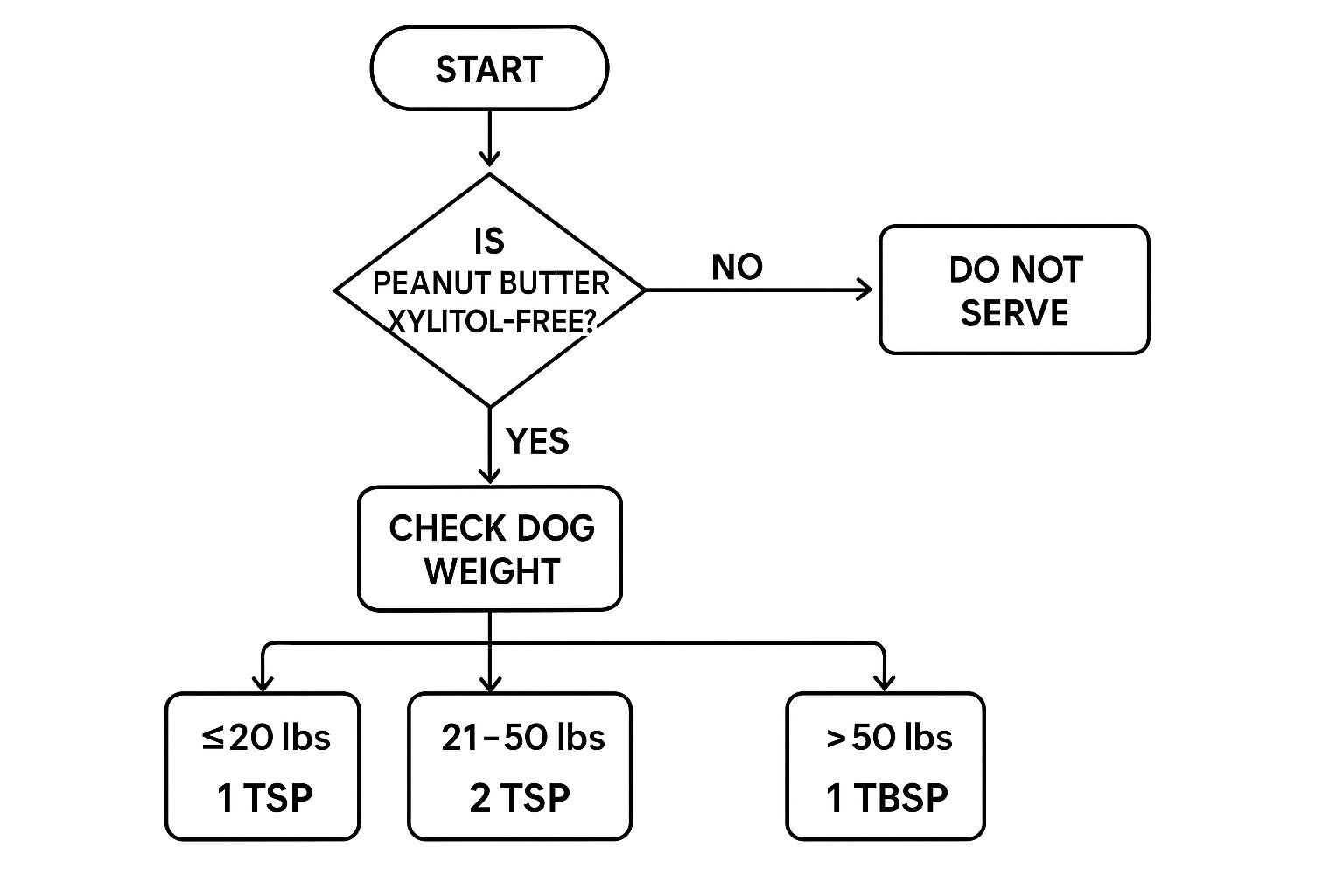
As you can see, making sure there's no xylitol is always the very first thing you should do.
A Quick-Reference Guide: Decoding The Label
To make things even clearer, here’s a quick table you can mentally reference when you're standing in the store, staring at a wall of peanut butter jars.
Dog-Safe vs Unsafe Peanut Butter Ingredients
| Ingredient | Is It Safe for Dogs? | Why or Why Not? |
|---|---|---|
| Organic Peanuts | Yes | The primary, healthy ingredient. A great source of protein and healthy fats. |
| Xylitol/Birch Sugar | NO (Extremely Toxic) | Causes a rapid, life-threatening drop in blood sugar and can lead to liver failure. |
| Sugar/Cane Sugar | No | Unnecessary calories that can contribute to obesity, diabetes, and dental issues. |
| Salt | No | High sodium levels can lead to dehydration and other health problems for dogs. |
| Palm Oil | No | An added, unhealthy fat that can cause digestive upset and diarrhea. |
| Other Oils | Use Caution | Hydrogenated or processed oils add unnecessary fat. Stick to peanut-only options. |
This table really drives home the point: the fewer ingredients, the better.
Human-Grade vs. Dog-Specific Brands
You've probably seen peanut butters made just for dogs. Are they worth it?
Often, these are fantastic choices because they're specifically formulated to be safe. The downside is they usually come with a higher price tag.
The good news is that a high-quality, human-grade organic peanut butter is just as good, and often cheaper, as long as it meets our safety checklist: no xylitol, no salt, no sugar, and no extra oils. It's not about who the jar is marketed to; it's about what's in the jar.
The ultimate goal is to find a product with a single ingredient: 100% organic peanuts. This minimalist approach guarantees you're giving your pup a clean, wholesome treat without any hidden risks.
At the end of the day, peanut butter is just one of many options for rewarding your furry friend. If you want to mix things up, check out our guide to the healthiest treats for dogs. By sticking to these simple rules, you can feel confident that the jar of peanut butter you choose is one your dog will go crazy for and you can feel great about giving.
Serving Ideas and Smart Portion Control
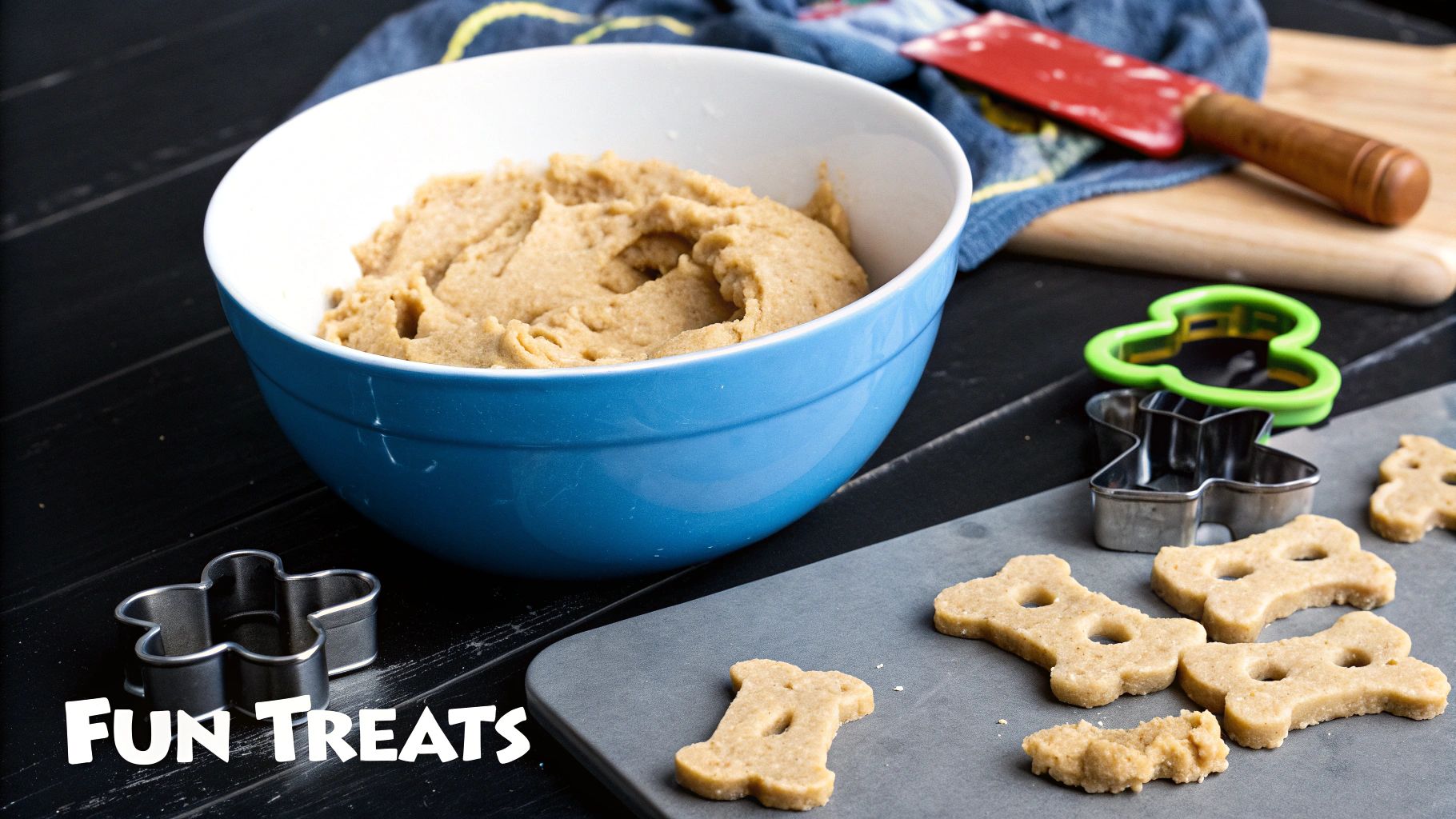
Even with the best organic peanut butter, it’s all about balance. While it’s loaded with good stuff, it’s also high in calories and fat. Giving your dog too much of a good thing can quickly lead to weight gain. Think of it as a special bonus, not a staple of their diet.
A fantastic rule of thumb to live by is the 10% rule. This simply means that treats—peanut butter included—should never make up more than 10% of your dog's daily calorie intake. This keeps their main, balanced dog food as the star of the show and helps you sidestep the health problems that come from over-treating.
How Much Is Just Right?
So what does that 10% actually look like? The perfect amount really depends on your dog's size and how active they are, but here are some solid starting points to keep things in a healthy range.
- Small Dogs (under 20 lbs): Just a small dab will do—think about half a teaspoon per day.
- Medium Dogs (20-50 lbs): You can go up to one full teaspoon daily.
- Large Dogs (over 50 lbs): Keep it to no more than one tablespoon per day.
Treat it like a high-value reward for nailing a new trick or a fun way to enrich their day, not just another meal. This keeps the treat special and ensures its calories don't throw your dog's diet out of whack. Sticking to these guidelines makes it a safe and fun experience every single time.
Just a heads-up: these are general guidelines. If your dog has any health issues or is watching their weight, it's always smart to check in with your veterinarian. They can help you figure out the perfect portion for your pup's unique needs.
Creative Ways to Serve Peanut Butter
Why stick to just a spoon? Organic peanut butter is a fantastic tool for beating boredom and giving your dog’s brain a workout. Getting creative turns a simple treat into an engaging activity that keeps them happy and mentally sharp.
Here are a few popular ideas to get you started:
- Stuff a Puzzle Toy: This is a classic for a reason. Smear a spoonful inside a Kong or another tough puzzle toy. It makes your dog work for the reward, which is a great way to burn off some mental energy.
- Make Frozen Pupsicles: On a hot day, nothing beats a cool treat. Mix a little peanut butter with plain yogurt or water and freeze the mixture in an ice cube tray.
- Level Up Your Training: A tiny dab on your fingertip works wonders as a high-value reward. It's perfect for teaching a tricky new command or reinforcing really good behavior.
- Disguise Medications: Let's be honest, getting a dog to take a pill can be a battle. The sticky texture and irresistible taste of peanut butter make it the ultimate trick for hiding medicine.
Understanding Allergies and Other Risks
Even though organic peanut butter is a fantastic treat for most dogs, it's always smart to be mindful of potential issues, just like with any new food you introduce to their diet. Peanut allergies in dogs aren't nearly as common as they are in people, but they do happen. The key is to start slow and pay attention.
When you first offer your dog peanut butter, don't just hand over a spoonful. A tiny dab on your finger is all you need. After that, just keep an extra close eye on them for the next 24 hours to see how they react.
Spotting a Potential Problem
Allergic reactions in dogs often look different than you might expect. Instead of the respiratory symptoms we see in humans, a dog's reaction usually shows up on their skin or as a tummy ache.
Here’s what to watch for:
- Non-stop Itching: Is your dog suddenly scratching like crazy? Or maybe they're constantly licking and chewing at their paws? This is a classic sign.
- Ear Infections: Allergies can often trigger ear problems. Look for redness, a funky smell, or frequent head shaking.
- Digestive Upset: Vomiting, diarrhea, or unusual gassiness after trying the new treat can point to an intolerance or allergy.
- Skin Issues: Keep an eye out for rashes, hives, or any puffiness, especially around their face and snout.
It's worth noting that these symptoms can be caused by other things, too. If you're curious about other ingredients that might cause trouble, check out our guide on ingredients to avoid in dog treats.
Aflatoxins: A Hidden Concern
Beyond allergies, there's another potential risk with peanuts called aflatoxins. This is a nasty toxin produced by a specific type of mold that can grow on peanuts if they aren't stored or handled properly.
This is exactly why splurging on a high-quality organic brand is so important.
Good, reputable brands are well aware of this risk and take serious steps to prevent it. They source only the best food-grade peanuts and use processing methods like blanching and dry roasting, which are proven to drastically reduce any mold. Plus, they run strict tests on their batches to screen for any contaminants, ensuring the final product is safe for your pup.
By choosing a brand you trust and introducing the treat carefully, you can minimize the risks and just focus on the fun of sharing organic peanut butter with your best friend.
Frequently Asked Questions
When it comes to treating our dogs, it's natural to have a few questions. Let's clear up some of the common ones about sharing organic peanut butter with your furry friend.
Can I Just Grab the Organic Peanut Butter From My Pantry?
Not so fast! Before you share your spread, you absolutely must check the label. The most critical thing to look for and avoid is xylitol, an artificial sweetener that’s incredibly dangerous for dogs.
Even if it's xylitol-free, the best choice for your pup is a peanut butter with no added sugar, salt, or extra oils like palm oil. The gold standard is a jar with just one ingredient: organic peanuts.
How Much Is a Safe Amount to Give My Dog?
With any treat, moderation is the name of the game. A fantastic rule of thumb to follow is the 10% rule: treats should only account for about 10% of your dog's daily calorie intake, and never more.
What does that look like in real life?
- Small Dogs: Think about half a teaspoon per day.
- Larger Breeds: You can go up to one full tablespoon daily.
Following these guidelines helps ensure this special snack doesn't lead to unhealthy weight gain.
Keep in mind, these are just general suggestions. It's always a good idea to chat with your vet about your dog's specific dietary needs, especially if they have any health issues.
Is Crunchy or Smooth a Better Choice?
As long as the peanut butter is free of xylitol, salt, and sugar, both crunchy and smooth versions are perfectly fine for most dogs.
Smooth peanut butter can be a bit more practical, though. It’s easier to smear inside puzzle toys or use for hiding pills. For puppies or tiny breeds, smooth also minimizes any potential choking hazard.
Ready to treat your pup to something you can feel great about? Joyfull creates clean, high-quality pet products with your dog's health and happiness at the forefront. Take a look at our wholesome options at https://joyfullpet.com.
